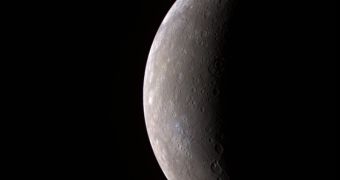Our planet's magnetic field is strong enough to protect the surface from deadly radiation coming from the Sun, and, without it, the Earth would probably be pretty much dead. The Earth is being daily bombarded with massive amounts of solar wind, still Mercury receives even more radiation considering the fact that it is two thirds closer to the Sun than our planet, and somehow manages to repel much of the solar wind back into space with its weak magnetosphere.
Data collected with NASA's Messenger spacecraft during the fly-by around Mercury of 14 January, showed that the planet's magnetosphere presents strong interactions with the stream of charged particles carried by the solar wind.
Measurements made with instruments provided by the University of Michigan revealed that, although Mercury has a weak magnetosphere, it is still capable of reflecting most of the solar wind back into space, in order to protect its surface. Thomas Zurbuchen from the U-M Department of Atmospheric, Oceanic and Space Science stated that the FIPS instrument Messenger has on board detected layers of plasma moving around slowly around the planet, and it is possible that its magnetosphere has some holes into its shield as the solar wind is partially capable of penetrating through the magnetic field in polar areas to determine the formation of ions in the magnetosphere.
Zubuchen also said that the data collected during the fly-by is not yet sufficient to determine the chemical compositions of the ions or even their origin, but it is now clear that Mercury's magnetosphere is, in fact, more Earth-like than previously thought, with one small difference though. Unlike Earth, which presents belts of energetic particles captured by the powerful magnetic field, Mercury has no Van Allen Belts. Messenger passed right through the areas where scientists predicted such belts would occur, but it was unable to detect any.
Earth and small Mercury are the only two planets in the solar system that create magnetospheres with the help of an intrinsic magnetic field. Messenger's fly-by on 14 January was only the first of a series of three which will put it in a stable orbit around the planet by the year 2011.

 14 DAY TRIAL //
14 DAY TRIAL //